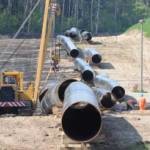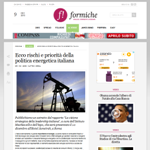 Nonostante il suo mandato scada tra pochi mesi, la Commissione europea ha pubblicato la scorsa settimana le sue proposte per una Strategia per la Sicurezza Energetica Europea.
Nonostante il suo mandato scada tra pochi mesi, la Commissione europea ha pubblicato la scorsa settimana le sue proposte per una Strategia per la Sicurezza Energetica Europea.
Rispondendo alle richieste del Consiglio europeo di marzo, e tenendo in considerazione in primo luogo i rischi connessi alla crisi russo-ucraina, la Commissione ha ribadito la necessita di adottare una strategia “testarda”, che promuova la capacità dell’Unione di resistere nel breve termine agli shock e alle interruzione dei rifornimenti energetici e che, nel lungo periodo, consenta alla stessa Unione di ridurre la dipendenza da particolari fonti di energia, particolari fornitori o particolari vie d’approvvigionamento.
Per fare questo è necessario ci sia la volontà degli Stati membri di coordinarsi e cooperare attivamente, anteponendo la prospettiva comunitaria a quella strettamente nazionale. Si tratta di qualcosa più facile a dirsi che a farsi, visto che i vari Stati membri presentano situazioni fortemente differenziate e quindi non è facile per i vari governi superare gli egoismi nazionali e adottare atteggiamenti più solidali.
A questo punto la palla passa al Consiglio europeo, che si riunirà il 26 e 27 giugno e che dovrà anche esprimersi sulle proposte circa le politiche energetico-climatiche per il 2030.
PS: guardando all’elenco delle infrastutture che per la Commissione sono importanti per garantire la sicurezza enegetica nei vari paesi membri viene da chiedersi chi pagherà il tutto. La trentina di infrastrutture elencate hanno infatti un costo di realizzazione di alcune decine di miliardi di euro ed è poco plausibile che i privati saranno disposti a metterceli tutti, tanto più che la domanda di energia in Europa è stagnante e il consumo di gas in Europa dovrebbe addirittura cadere, se venisse attuato il piano proposto dalla Commissione per il 2030. D’altra parte, la sicurezza è un bene pubblico e il mercato non è il miglior meccanismo per garantirne un’adeguata offerta.










